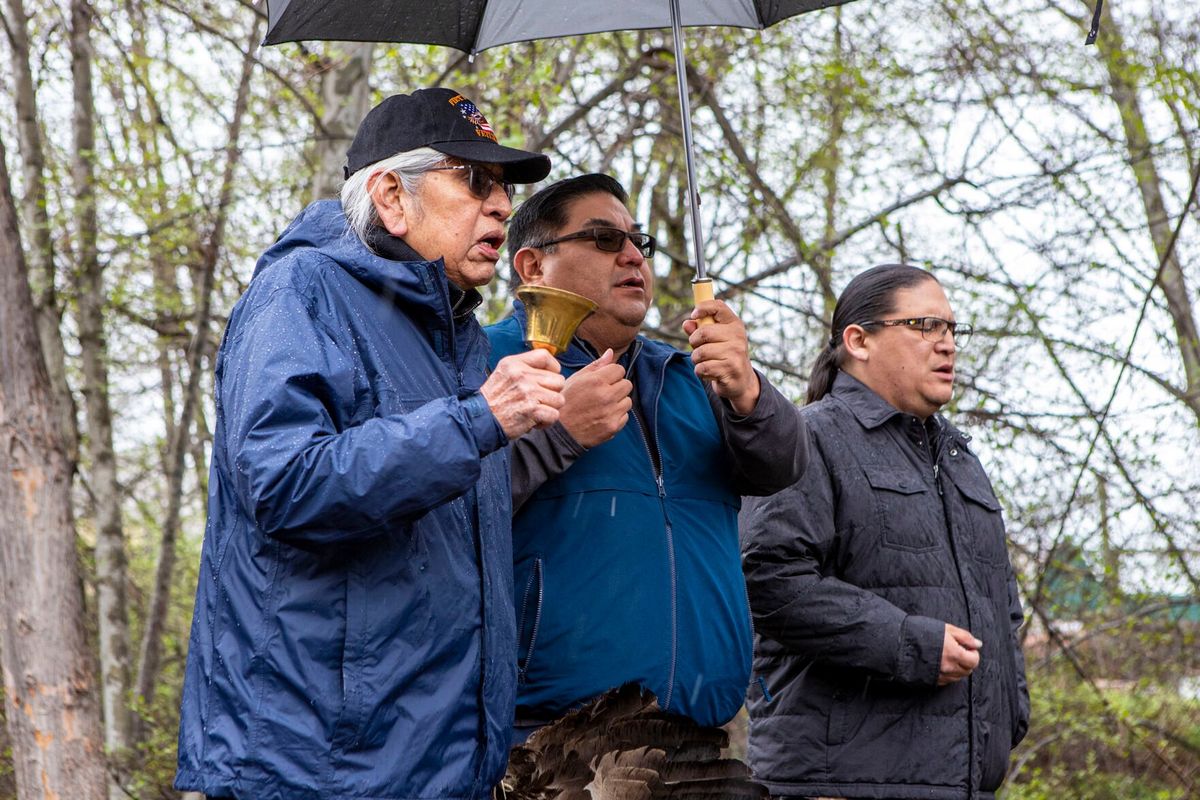Nez Perce Tribe releases Pacific lamprey into Asotin Creek as part of program to help ancient fish survive

Chuck Axtell rang a bell and Shannon Wheeler rapped a drum as part of an extended blessing and welcoming ceremony for about a dozen Pacific lampreys just upstream from the mouth of Asotin Creek.
One by one, members of the Nez Perce Tribe and their guests delicately released the squirming fish into the cold rushing water. Moments earlier, Axtell sang the tribe’s “Circle of Life’’ song in the Nez Perce language.
“That song is blessing them, that they will complete the circle,” he said.
The fish, with some help from humans, are close to doing just that and helping ensure the species retains its fragile grip in the vast Snake River ecosystem.
The long fish with a toothy disc mouth, known as heésu, were once common. Nez Perce people came to the creek to catch lampreys, which were an important source of food and medicine. The creek and the town of Asotin would eventually take their name from a mispronunciation of Hesuutin, a Nez Perce word that means “place of the eels.”
But the scaleless fish are now rare here and everywhere in the Snake River basin. Dams on the Columbia and Snake rivers make it nearly impossible for adult lampreys to reach spawning grounds.
“Lamprey are an anadromous fish. They migrate to the ocean and return,” said Samuel N. Penney, chairman of the Nez Perce Tribal Executive Committee. “At each of the dams, at least 50% are lost.”
In 2007, the tribe began collecting lampreys at dams on the Columbia River and trucking them to Snake River tributaries for release. In all, about 6,000 of the fish have been moved upriver and released in places including Asotin Creek, the south fork of the Salmon River, the south fork of the Clearwater River and tributaries to the Grande Ronde River.
“We just let them hitch a ride with us. We get them up past the barriers and then we release them to do their thing,” said Todd Sween, a lamprey biologist with the tribe’s Department of Fisheries Resources Management.
Jon Hess, a scientist with the Columbia River Inter-Tribal Fish Commission, of which the Nez Perce Tribe is a member, has used genetic testing to document that the translocated lampreys have successfully spawned and their offspring have migrated to the ocean.
“Everywhere we have put them, everywhere we have released adults, we have documented successful reproduction,” Sween said.
That is important because unlike salmon and steelhead, lampreys do not have fidelity to the particular streams where they were hatched. Instead, mature adults key in on pheromones released by larval lampreys to find suitable spawning habitat. So while a lamprey from the Snake River basin could return to the river to spawn, it might also return to another Columbia River tributary or any river on the West Coast. Once a river becomes devoid of juvenile lampreys, little remains to attract adults to spawning areas, no matter how pristine they may be.
“That is the primary objective of our work – getting the adults up here, getting the young established so they can give off that pheromone plume,” Sween said.
The fish released last week, which also included about 100 more that were placed farther upstream, are part of that stopgap program.
“We understand this is a Band-Aid approach and there is a long term fix that needs to be done,” Penney said.
The Army Corps of Engineers has experimented with ways to improve lamprey passage at dams, but the work has just begun and yet to prove successful. Last year, only 31 lampreys were counted passing Lower Granite Dam. The 10-year average is 102.
The tribe supports breaching the four lower Snake River dams as a means to saving lampreys and threatened and endangered stocks of salmon and steelhead. The Snake River and its nearly pristine tributaries are viewed by scientists as an important stronghold for salmon and steelhead that could be unleashed through breaching.
Sween said that same high-quality habitat could also be key to saving lampreys. As juveniles, lampreys spend years filter-feeding in the sand and silt of river beds. They are especially vulnerable to pollution and need clean water to survive.
“Here in Nez Perce country,” he said, “we are blessed with just relatively pristine watersheds.”